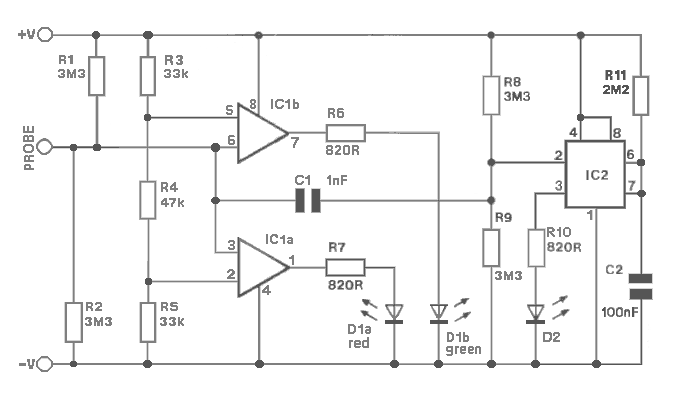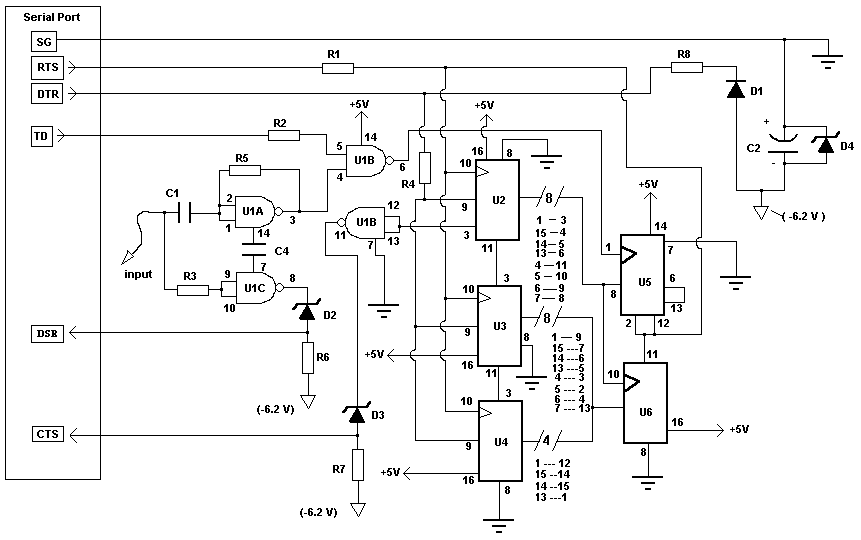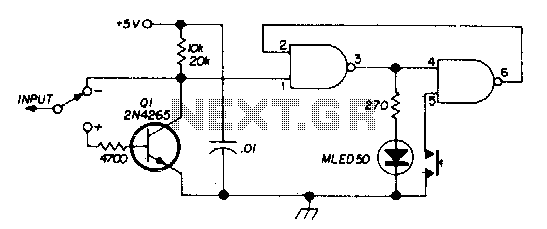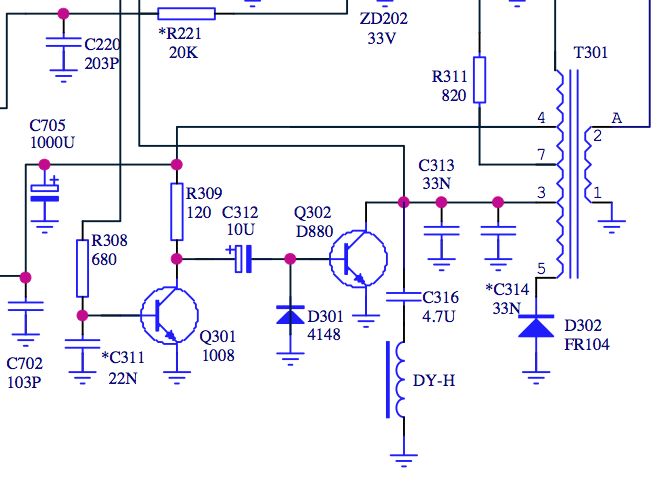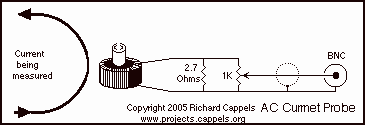
Scope Probe
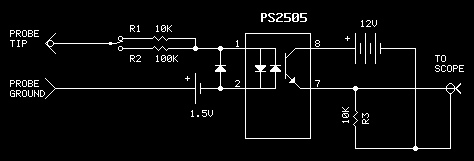
Working on live telephone circuits can be a problem. You just can't connect a normal scope probe to the circuit while it is tied to the phone line. Neither side of a phone line is ground. When a phone or other device is 'off-hook', one side floats at about -22 volts and the other side about -30 volts. This probe allows connecting to such 'floating' circuits to a normal scope input. As seen in the circuit, it is based on using an optocoupler. The one shown in the diagram is a dual unit, but I had a pile of them here, so that's what I used. Because this device responds to both polarities, an external diode was added to prevent negative voltages from producing an output. The input has 2 ranges: 1 to 1, and 10 to 1. There is no need for a power switch because with no input, virtually no power is drawn from the 12 volt (keyfob) battery. Also, no power is drawn from the 1.5 volt (watch) battery.
Because of variations in individual optocouplers, you should select a value for R3 to get the best results.
Now for the bad news.....
This device is inherently non-linear. The small battery on the input side helps compensate by giving an initial bias to the optocoupler's input LED. Also, presenting a 10k load to some circuits will cause additional error in the output. The non-linearity is not too bad from 0 to 5 volts; above that, it is not very usable.
Nonetheless, this little gadget has already 'paid for itself' in making some timing and voltage measurements of how a circuit responds to a telephone ring signal.
This circuit is designed to safely interface with live telephone lines for measurement purposes. The primary component of the circuit is an optocoupler, which provides electrical isolation between the high-voltage telephone line and the measuring equipment, such as an oscilloscope. The optocoupler's LED is biased using a small battery, allowing it to function correctly even when the telephone line is floating at negative voltages.
The circuit features two input ranges: a direct 1:1 ratio and a 10:1 ratio, enabling flexibility in measuring different voltage levels. The absence of a power switch is a deliberate design choice, as the circuit draws negligible power when not in use, thanks to the low consumption characteristics of the optocoupler and the biasing battery.
It is important to note that the performance of the circuit may vary based on the specific optocoupler used, necessitating the adjustment of resistor R3 to optimize the output response. The design acknowledges the inherent non-linearity of the system, particularly at higher voltage levels. While the output is reliable and accurate within the 0 to 5 volts range, deviations may occur beyond this threshold, especially when interfaced with loads such as a 10k resistor.
In application, this device proves beneficial for measuring the response characteristics of telephone circuits, such as detecting ringing signals and assessing timing measurements, thereby providing valuable insights without the risk of damaging sensitive measuring equipment.Working on live telephone circuits can be a problem. You just can't connect a normal scope probe to the circuit while it is tied to the phone line. Neather side of a phone line is ground. When a phone or other device is 'offhook', one side floats at about -22 volts and the other side about -30 volts. This probe allows connecting to such 'floating' circuits to a normal scope input. As seen in the circuit, it is based on using an optocoupler. The one shown in the diagram is a dual unit, but I had a pile of them here, so thats what I used. Because this device responds to both polarities, an external diode was added to prevent negative voltages from producting an output.
The input has 2 ranges: 1 to 1, and 10 to 1. There is no need for a power switch because with no input, virtually no power is drawn from the 12 volt (keyfob) battery. Also, no power is drawn from the 1.5 volt (watch) battery. Because of variations in individual optocouplers, you should select a value for R3 to get the best results.
Now for the bad news..... This device is enherently non-linear. The small battery on the input side helps compensate by giving an initial bias to the optocoupler's input LED. Also, presenting a 10k load to some circuits will cause addional error in the output. The non-linearity is not too bad from 0 to 5 volts, above that, it is not very usable. Nonetheless, this little gadget has already 'paid for itself' in making some timing and voltage measurments of how a circuit responds to a telephone ring signal.
🔗 External reference
Because of variations in individual optocouplers, you should select a value for R3 to get the best results.
Now for the bad news.....
This device is inherently non-linear. The small battery on the input side helps compensate by giving an initial bias to the optocoupler's input LED. Also, presenting a 10k load to some circuits will cause additional error in the output. The non-linearity is not too bad from 0 to 5 volts; above that, it is not very usable.
Nonetheless, this little gadget has already 'paid for itself' in making some timing and voltage measurements of how a circuit responds to a telephone ring signal.
This circuit is designed to safely interface with live telephone lines for measurement purposes. The primary component of the circuit is an optocoupler, which provides electrical isolation between the high-voltage telephone line and the measuring equipment, such as an oscilloscope. The optocoupler's LED is biased using a small battery, allowing it to function correctly even when the telephone line is floating at negative voltages.
The circuit features two input ranges: a direct 1:1 ratio and a 10:1 ratio, enabling flexibility in measuring different voltage levels. The absence of a power switch is a deliberate design choice, as the circuit draws negligible power when not in use, thanks to the low consumption characteristics of the optocoupler and the biasing battery.
It is important to note that the performance of the circuit may vary based on the specific optocoupler used, necessitating the adjustment of resistor R3 to optimize the output response. The design acknowledges the inherent non-linearity of the system, particularly at higher voltage levels. While the output is reliable and accurate within the 0 to 5 volts range, deviations may occur beyond this threshold, especially when interfaced with loads such as a 10k resistor.
In application, this device proves beneficial for measuring the response characteristics of telephone circuits, such as detecting ringing signals and assessing timing measurements, thereby providing valuable insights without the risk of damaging sensitive measuring equipment.Working on live telephone circuits can be a problem. You just can't connect a normal scope probe to the circuit while it is tied to the phone line. Neather side of a phone line is ground. When a phone or other device is 'offhook', one side floats at about -22 volts and the other side about -30 volts. This probe allows connecting to such 'floating' circuits to a normal scope input. As seen in the circuit, it is based on using an optocoupler. The one shown in the diagram is a dual unit, but I had a pile of them here, so thats what I used. Because this device responds to both polarities, an external diode was added to prevent negative voltages from producting an output.
The input has 2 ranges: 1 to 1, and 10 to 1. There is no need for a power switch because with no input, virtually no power is drawn from the 12 volt (keyfob) battery. Also, no power is drawn from the 1.5 volt (watch) battery. Because of variations in individual optocouplers, you should select a value for R3 to get the best results.
Now for the bad news..... This device is enherently non-linear. The small battery on the input side helps compensate by giving an initial bias to the optocoupler's input LED. Also, presenting a 10k load to some circuits will cause addional error in the output. The non-linearity is not too bad from 0 to 5 volts, above that, it is not very usable. Nonetheless, this little gadget has already 'paid for itself' in making some timing and voltage measurments of how a circuit responds to a telephone ring signal.
🔗 External reference
